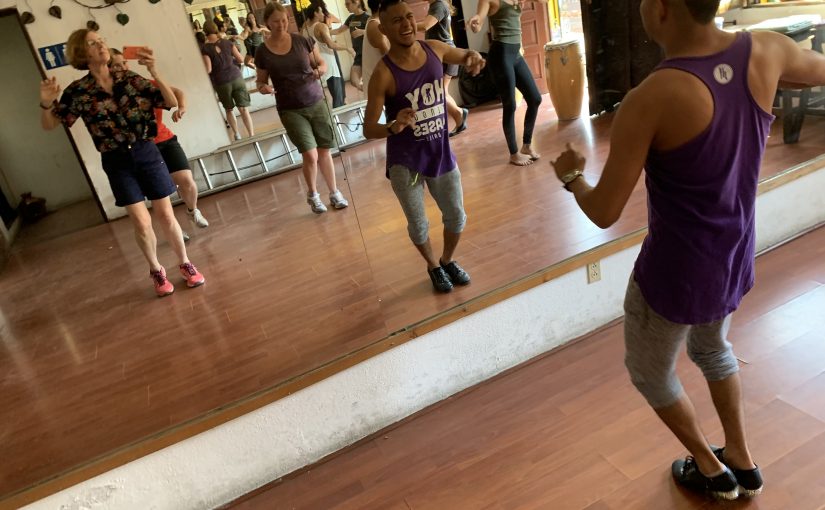Step number one: buy a poncho –
Step number two: take up salsa –
… but don’t try to take a photo and follow your teacher’s instructions, or you end up making a complete mess of both activities.
The lovely Martin was a tiny, swivel-hipped salsa god, who only winced slightly as I crushed his fingers when he spun me around.
‘The chicas, they do sexy hand, not strong hand,’ he advised me, after extracting his fingers from my clenched fist.
After that he found me another dance partner –
and we managed to finish the class with no crushed fingers or toes – a definite achievement.
Step number three: become a coffee expert –
Guatemala has been producing coffee since the 1850s, and was Central America’s main producer until very recently. Antigua is 5,000 feet above sea level, which is an ideal altitude, and they produce some of the best coffee in the country. It’s grown on the slopes of volcanoes and apparently has lots of chocolate hints and fruity notes.
The raw fruit tastes sweet, but that’s not what they’re interested in. Spit out the seeds, and you’ve got fresh coffee beans in your hand –
I was very impressed by the ingenuity of the device used to catch Japanese Beetles, which eat the coffee beans inside the fruit –
An empty plastic bottle is painted the colour of the ripe coffee berries, and a large hole is cut in the side. A small flask of ethanol mixed with methanol is suspended inside the neck of the bottle, and the bottom of the bottle is filled with soapy water. The device is then hooked onto a branch of the coffee bush. The beetles are attracted to the red colour of the bottle, once inside they get drunk on the eth/meth cocktail fumes and fall in the soapy water where they drown. This simple method catches 95% of these destructive beetles … genius!
Being Guatemala, the compulsory dress code for the coffee roasting room is poncho and hairnet –
Not my best look, I feel, so may not pursue a career as a Guatemalan coffee roaster.
Step number four: become a chocolate expert –
Antigua has a chocolate museum, and I signed up for a chocolate making workshop.
The Mayans called chocolate Chocol’haa, and the Aztecs called it Xocoatl, and both words mean bitter water. When the Spanish arrived, they didn’t want to drink bitter water, so they decided to add milk and call it choco-late. What I’m not clear about here is why they didn’t use the Spanish word for milk and call it choco-leche.
First we made cocoa husk tea, which is light and bitter, and apparently very healthy – full of antioxidants and (legal) mood enhancers. All you do is infuse the bean husks in hot water for 5 minutes and then strain and drink –
To make Xocoatl you have to pulverise the beans then grind them to a paste. Add water honey, chilli, cloves, cinnamon, vanilla and pour repeatedly from a great height to mix well –
None of us managed to pour as expertly as this, and quite a lot of Xocoatl ended up on the table or on the workshop participants.
Salome, our instructor, told us that the Mayans used cocoa beans as currency, and that one avocado cost 5 cocoa beans and one turkey cost 100 cocoa beans. How does she know that, I wondered. The Mayan civilisation collapsed in 900 AD, and I don’t suppose they left any supermarket price tags behind. But then I did a little research and discovered that images have been found in temples and pyramids of chocolate being traded in the form of cocoa beans, and they’ve even found counterfeit beans made out of clay.
Once the Spanish arrived and began trading with the Aztecs, the exchange rate was fixed at 140 cocoa beans to one Spanish Real, and as late as the 1850s the beans were still being used for small change.
Finally it was time for us to make our own chocolate bars, and to choose the flavourings we wanted to add. Trying to remain true to cocoa’s ethnic origins, I sniffily refused the coloured sprinkles, peanuts and sesame seeds, and decided to flavour mine with cocoa nibs, coffee beans, coconut and chilli –
Unfortunately I was a little heavy-handed with the chilli, and have created a confection with a kick like a mule, and which makes you sweat buckets. I don’t think Mr Cadbury needs to worry too much, the Barden Bar is definitely an acquired taste.















